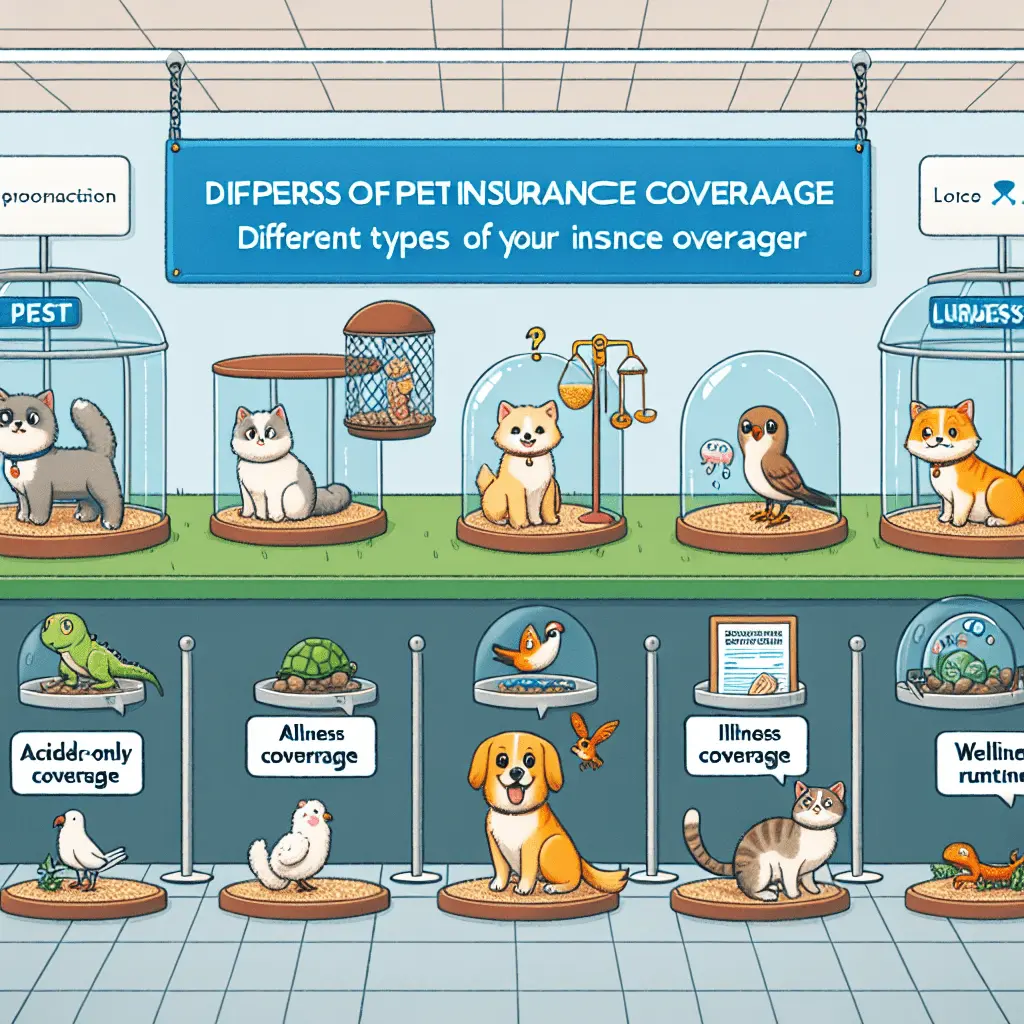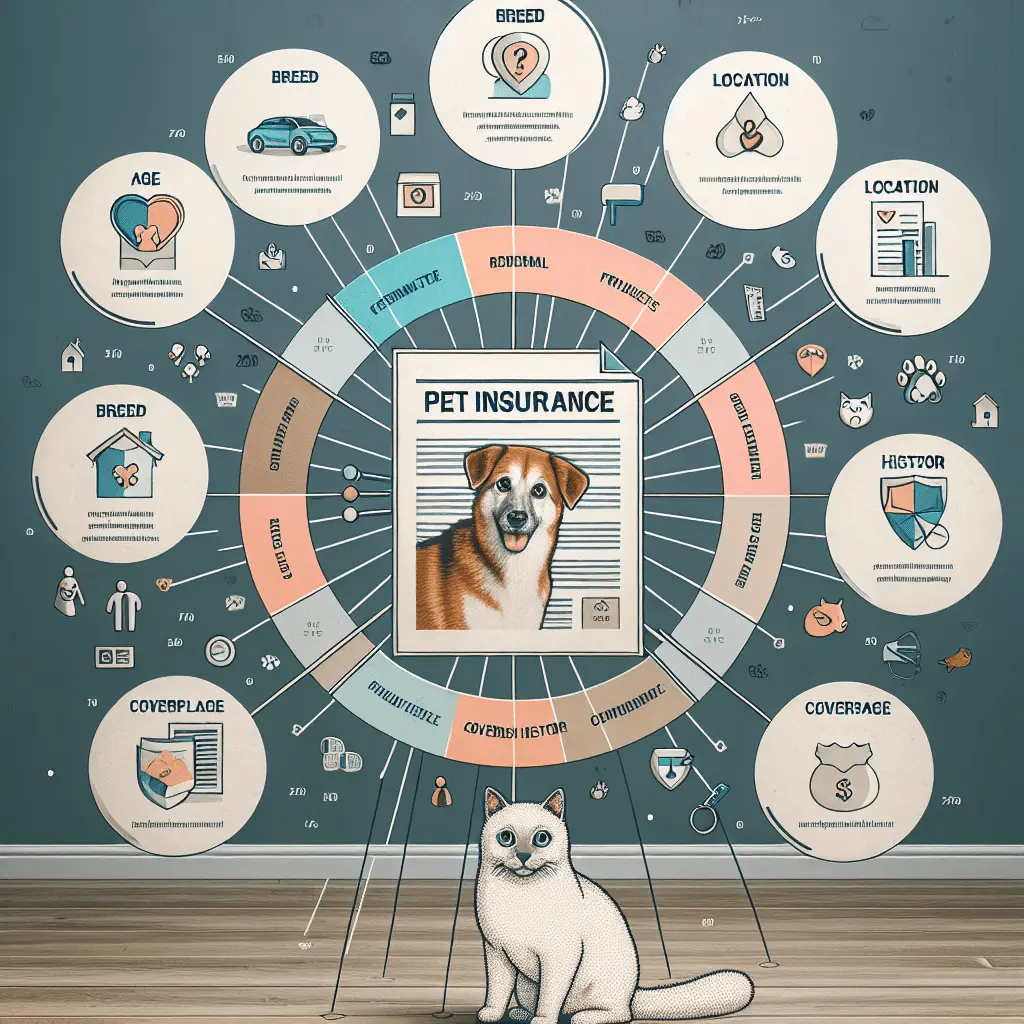Pet Insurance Secrets to Save on Care
Pet insurance offers financial protection for unexpected veterinary expenses. It involves selecting coverage level, deductible amount, and the best plan. Essential for peace of mind and ensuring prompt care for pets. Covers costs of veterinary care, from checkups to emergencies. Various coverage levels and deductible amounts available. Consider customizing plans to fit specific needs. Factors like pet breed, age, and health status influence costs. Multi-pet discounts and loyalty programs could enhance coverage. Providers offer specialized plans for senior pets. Pet insurance provides crucial financial security and all-encompassing care for beloved animals. Discover more about evaluating providers, policy terms, and real-life scenarios.
Introduction to Pet Insurance
Pet insurance offers a safety net for pet owners by helping cover unexpected veterinary expenses. Understanding how pet insurance works involves selecting a coverage level, setting a deductible amount, and choosing the best plan for a pet’s specific needs. With the escalating costs of pet healthcare, pet insurance plays an essential role in providing financial protection and peace of mind to pet owners.
Brief overview of pet insurance and its importance
Understanding the significance of insurance coverage for pets is crucial in ensuring the financial well-being and health security of companion animals. Pet insurance provides financial protection that can assist in covering veterinary care costs, offering peace of mind to pet owners in case of unexpected costs related to their pet’s health. With companion animal insurance, pet owners can feel more secure knowing that they can afford necessary medical treatments, including annual checkups and unforeseen emergencies. By having pet insurance in place, owners can focus on their pet’s well-being without the worry of significant financial burdens that may arise from veterinary care. It acts as a safety net, ensuring that pets receive the necessary care promptly.
Explanation of how pet insurance works
When considering insurance for their beloved companions, pet owners often seek clarity on the mechanics of how this financial safeguard operates. Pet insurance works as a form of risk management in the domain of pet care, providing financial services to cover veterinary expenses. Policies typically offer different coverage levels, such as accident and illness or wellness benefits, with varying deductible amounts. However, it’s essential to note that pre-existing conditions are usually not covered. Here is a simplified breakdown to help understand how pet insurance works:
| Aspect | Description |
|---|---|
| Coverage Level | Accident & Illness, Wellness Benefits |
| Deductible Amount | Varies based on policy |
The rise in pet healthcare costs and the role of pet insurance
Amidst the escalating costs of pet healthcare, the pivotal role of pet insurance in mitigating financial risks for pet owners is becoming increasingly evident. With veterinary care expenses on the rise, pet insurance offers a valuable solution to provide financial protection against unexpected costs. By paying affordable premiums, pet owners can guarantee that their pets receive necessary medical attention without facing exorbitant bills. Additionally, pet insurance often covers preventative care and wellness benefits, encouraging responsible pet ownership and proactive healthcare practices. By investing in pet insurance, owners can secure peace of mind knowing that their pets’ medical needs are covered, making it a critical component of managing the growing expenses associated with pet healthcare.
Understanding Different Types of Pet Insurance Coverage

When considering pet insurance, it is crucial to understand the various types of coverage available. There are Accident-only plans that provide coverage for unexpected injuries, All-encompassing (Accident and Illness) plans that cover accidents as well as illnesses, Wellness and preventive care add-ons for routine veterinary visits, and Customizable plans with additional riders to tailor coverage to specific needs. By familiarizing oneself with these different types of coverage, pet owners can make informed decisions to make sure their pets receive the appropriate care.
Accident-only plans
Accident-only plans are a type of pet insurance coverage that specifically caters to unexpected injuries suffered by pets. These plans provide financial protection by covering the costs of veterinary care resulting from accidents, offering pet owners peace of mind in the face of unforeseen expenses. With cost-effective premiums, accident-only plans enable effective risk management, ensuring that pet owners can provide their pets with the necessary medical attention without facing the full burden of unexpected costs. By opting for accident-only plans, pet owners can proactively safeguard their pets’ well-being and mitigate the financial impact of accidents, highlighting the importance of having all-encompassing pet insurance coverage tailored to different aspects of pet health.
Comprehensive (Accident and Illness) plans
Pet insurance coverage extends beyond all-encompassing plans to encompass inclusive options that address both accident and illness scenarios, providing a more holistic approach to safeguarding pets’ health and well-being. All-inclusive plans offer a wide range of benefits for pet owners, including:
- Accident and illness coverage: These plans provide financial protection for vet bills related to accidents and illnesses.
- Coverage level customization: Pet owners can choose the level of coverage that best suits their pets’ needs.
- Suitable for dogs and cats: All-inclusive plans cater to both canine and feline companions.
- Peace of mind: Owners can rest assured knowing that their pets have coverage for a variety of medical situations.
Wellness and preventive care add-ons
In the domain of pet insurance coverage, wellness and preventive care add-ons play an essential role in ensuring thorough healthcare for beloved animal companions. These add-ons typically cover routine expenses such as annual check-ups, vaccinations, flea and tick prevention, and more. By including wellness benefits in a pet insurance plan, pet owners can proactively manage their pets’ health and catch any issues early on. The coverage level for wellness and preventive care add-ons varies among insurance providers, as does the deductible amount. This additional coverage can help offset the costs of regular veterinary visits and promote a proactive approach to pet wellness. In case of emergencies, having wellness and preventive care add-ons can offer peace of mind and financial support.
| Coverage Level | Deductible Amount | Emergency Vet Care |
|---|---|---|
| Wellness Add-ons | Varies | Included |
Customizable plans and riders
To further enhance the scope of pet insurance coverage, customizable plans and riders offer tailored options for pet owners seeking specific benefits and additional protection for their beloved companions. When considering pet insurance, here are key features to look for:
- Tailored Plans: Customize coverage to suit your pet’s needs.
- Lifetime Protection Options: Guarantee continuous coverage throughout your pet’s life.
- Breed-Specific Discounts: Special discounts for certain breeds.
- 24/7 Customer Support: Access assistance at any time for your peace of mind.
These elements, along with considerations such as deductible amounts, pet types, and coverage levels (accident & illness, wellness), contribute to a detailed and personalized pet insurance plan.
Factors Influencing Pet Insurance Costs

When considering pet insurance costs, several key factors come into play. The species and breed of the pet, along with its age and current health status, heavily influence the insurance premiums. Additionally, the location and local veterinary costs, as well as the policy customization options such as deductibles, coverage limits, and reimbursement levels, play a significant role in determining the overall cost of pet insurance.
Species and breed of pet
What factors influence the costs of pet insurance when considering the species and breed of your pet? When it comes to species and breed, several key elements can impact the cost of pet insurance:
- Pet Type: Different premiums may apply based on whether your pet is a dog, cat, or exotic animal.
- Age: The age of your pet, whether they are a puppy, kitten, adult, or senior, can affect insurance costs.
- Breed: Certain breeds may have specific health risks or predispositions, leading to varied insurance rates.
- Coverage Level: The extent of coverage, including accident and illness protection, plays a role in determining the overall cost of pet insurance.
Age and health of the pet
Taking into account the species and breed of your pet can greatly impact the cost of pet insurance, with the age and health of the pet playing a crucial role in determining insurance costs. Age is a significant factor, as older pets are more prone to health issues, leading to higher insurance premiums. Senior dogs, for example, may require more frequent vet visits and specialized care, impacting the overall cost of coverage. Additionally, certain breeds may have genetic predispositions to specific conditions, affecting insurance rates. Exotic pets also pose unique risks due to their specialized care requirements. When selecting a pet insurance plan, consider the coverage level, deductible amount, and the specific needs of your pet to guarantee adequate protection while managing costs effectively.
Location and local veterinary costs
Location and local veterinary costs play a significant role in determining the expenses associated with pet insurance coverage. The geographical location of a pet owner can heavily influence the overall cost of pet insurance due to variations in regional veterinary fees. Here are some key points to ponder regarding this topic:
- Regional Veterinary Fees: Different areas may have varying costs for veterinary services, impacting the overall expenses of pet insurance.
- Local Vet Expenses: The prices charged by local veterinary services can affect the premiums of pet insurance plans.
- Pet Insurance Benefits: Higher local veterinary costs may lead to increased benefits and coverage in pet insurance plans.
- Geographical Location: Living in certain areas with higher veterinary expenses can result in higher pet insurance costs.
Policy customization (deductibles, coverage limits, reimbursement levels)
The personalization of pet insurance policies, including adjustments to deductibles, coverage limits, and reimbursement levels, plays a crucial role in determining the overall costs and benefits for pet owners. By offering tailored plans, insurance providers allow pet owners to customize their coverage to meet their specific needs and budget constraints. Factors such as lifetime coverage options, breed-specific discounts, and wellness benefits further enhance the flexibility of these policies. Pet owners can choose deductible amounts that suit their financial capabilities, set coverage limits based on their perceived risks, and select reimbursement levels that align with their preferences. This level of customization guarantees that pet insurance remains accessible and relevant to a wide range of pet owners with varying requirements.
Evaluating Pet Insurance Providers

When assessing pet insurance providers, it is crucial to take into account factors like the insurer’s reputation and financial stability, the quality of customer service and support offered, as well as the efficiency of claim processing times and procedures. Additionally, understanding whether the insurer provides direct payment to veterinarians or follows a reimbursement model can impact your experience. User reviews and testimonials can also offer valuable insights into the overall satisfaction and experiences of other pet owners with the insurance provider.
Reputation and financial stability of the insurer
When evaluating pet insurance providers, it is crucial to thoroughly assess their reputation and financial stability to guarantee reliable coverage for your beloved pet’s healthcare needs. To make an informed decision, consider the following:
- Industry Ratings: Look for insurers with high ratings from reputable financial services agencies for added peace of mind.
- Company History: Research the insurer’s background, including how long they have been offering companion animal insurance to assess their experience and stability.
- Claims Process: Evaluate customer reviews on the efficiency of the insurer’s claims process to make sure quick financial protection when needed.
- Financial Strength: Check the insurer’s financial stability through independent ratings to confirm they can meet their obligations and provide consistent coverage.
Customer service and support
Evaluating the quality of customer service and support provided by pet insurance companies is essential for ensuring a seamless experience in managing your pet’s healthcare needs. When selecting a pet insurance provider, consider aspects such as 24/7 customer support, pet insurance customer service, pet insurance support, pet insurance customer support, pet insurance company support, pet insurance assistance, and veterinary support. A reliable pet insurance company should offer prompt and efficient assistance for any inquiries or claims you may have regarding your pet’s coverage. Clear communication channels, knowledgeable staff, and a commitment to resolving customer issues are key indicators of good customer service in the pet insurance industry. Prioritizing excellent customer support can greatly enhance your overall experience with a pet insurance provider.
Claim processing times and procedures
Claim processing efficiency is a critical factor to take into account when evaluating the performance of pet insurance providers. To assess this aspect effectively, consider the following key elements:
- Claim submission process: Evaluate how easy it is to submit a claim and whether the provider offers online claim submission options.
- Claim reimbursement timeline: Look into the average time it takes for the insurance company to reimburse a claim once it has been submitted.
- Claim approval process: Understand the steps involved in the claim approval process and the criteria used to assess claim validity.
- Claim documentation requirements: Familiarize yourself with the type of documentation needed to support a claim and make sure you can readily provide it.
Direct payment to veterinarians vs. reimbursement models
In the domain of pet insurance evaluation, an important consideration lies in the comparison between direct payment to veterinarians and reimbursement models offered by insurance providers. Direct payment to veterinarians involves the insurance company paying the veterinary bill directly, providing immediate financial relief to the pet owner. On the other hand, reimbursement models require the pet owner to pay the veterinary bill upfront and then file a claim to be reimbursed by the insurance provider. While direct payment offers convenience and peace of mind by eliminating out-of-pocket expenses at the time of treatment, reimbursement models may provide more flexibility in choosing a veterinarian and treatment options. Both approaches aim to provide financial protection to pet owners against unexpected vet bills, promoting pet wellness through accessible veterinary coverage.
User reviews and testimonials
When considering pet insurance providers, perusing user reviews and testimonials can offer valuable insights into the quality of service and coverage options available. User feedback can help pet owners gauge the overall satisfaction levels and experiences of other customers. Here are some key aspects to look out for in user reviews and testimonials:
- Coverage Level: Understand if the policy adequately covers unexpected vet bills.
- Deductible Amount: Evaluate how the deductible amount affects the out-of-pocket expenses.
- Customizable Plans: Check if the provider offers customizable plans to suit your pet’s specific needs.
- Breed-Specific Discounts: See if there are any discounts available for certain breeds to help save on costs.
Policy Terms and Exclusions

Policy terms and exclusions play an essential role in understanding the coverage provided by pet insurance. Key points to ponder include pre-existing conditions, breed-specific exclusions, hereditary conditions, waiting periods for coverage initiation, and annual or lifetime coverage limits. By grasping these aspects, pet owners can make informed decisions about the level of protection and financial security they desire for their beloved animals.
Understanding pre-existing conditions
Understanding pre-existing conditions in pet insurance policies is essential for pet owners seeking financial protection for their companion animals’ healthcare needs. When considering coverage for pre-existing conditions, it is important to be aware of the following:
- Limited Coverage: Many pet insurance policies do not cover pre-existing conditions, which are typically defined as any illness or injury that your pet showed signs of before the policy’s effective date.
- Exclusion Period: Some insurers may have a waiting period before covering pre-existing conditions, often ranging from a few months to a year.
- Impact on Reimbursement: Vet bills related to pre-existing conditions are usually not eligible for reimbursement.
- Accident & Illness Coverage: Focus on finding a policy that offers comprehensive accident and illness coverage while understanding pre-existing condition limitations.
Breed-specific exclusions and hereditary conditions
To guarantee comprehensive coverage for your pet’s health needs, it’s important to be mindful of any breed-specific exclusions and hereditary conditions outlined in your insurance policy. Breed-specific exclusions refer to certain medical conditions that are more common in specific breeds and may not be covered by your pet insurance policy. Hereditary conditions are health issues that are passed down through generations and may also have limited coverage under certain plans. Understanding these exclusions and conditions is essential when selecting a pet insurance policy to make sure you are prepared for any unexpected veterinary care costs. Consider the coverage level, deductible amount, and any pre-existing conditions that may affect your policy’s terms to make an informed decision that aligns with your pet’s needs and your budget.
Waiting periods for coverage to start
When does the waiting period for coverage to start typically begin in pet insurance policies?
- Coverage Effective Date: The waiting period usually starts on the policy’s effective date.
- Duration: Waiting periods commonly last from 14 to 30 days.
- Exceptions: Some insurance providers may have shorter waiting periods for accidents compared to illnesses.
- Preventative Care: Coverage for preventative care often has a separate waiting period.
Waiting periods in pet insurance policies play an important role in managing risk for insurance providers and ensuring the financial stability of the policy. Understanding these waiting periods is essential for pet owners to plan and manage their pet care expenses effectively.
Annual and lifetime coverage limits
The annual and lifetime coverage limits in pet insurance policies are crucial components that define the financial boundaries of the policy’s benefits. Lifetime coverage guarantees that a pet is covered for chronic conditions throughout its life, subject to policy terms and exclusions. Annual coverage limits specify the maximum amount the insurance provider will pay out for covered expenses within a policy year. Some policies may have annual deductibles that need to be met before coverage kicks in. It’s important to take into account these limits when selecting a policy, especially for senior pets who may require more frequent medical attention. Some insurers offer breed-specific plans, multiple pet discounts, and pet wellness options, but pre-existing conditions are typically excluded from coverage.
How to Choose the Right Pet Insurance Plan

When selecting the appropriate pet insurance plan, it is essential to evaluate your pet’s specific healthcare requirements thoroughly. Comparing various quotes and coverage options will help you make an informed decision based on your pet’s needs and your budget. Additionally, considering the long-term costs and benefits, as well as carefully reading and understanding the policy’s fine print, are vital steps in choosing the right pet insurance plan for your beloved companion.
Assessing your pets healthcare needs
Evaluating your pet’s healthcare needs is an essential step in selecting the most appropriate pet insurance plan to ensure comprehensive coverage for your furry companion. When examining your pet’s healthcare needs, consider the following:
- Accident & Illness Coverage: Determine the level of coverage needed for unforeseen medical emergencies and illnesses.
- Wellness Benefits: Assess if you want coverage for routine care such as vaccinations, check-ups, and preventative treatments.
- Pre-existing Conditions: Understand how pre-existing conditions are handled by different insurance providers.
- Pet Budgeting: Evaluate your financial capability to determine the premium amount you can afford while ensuring adequate coverage for your pet’s healthcare needs.
Comparing quotes and coverage options
Comparing quotes and coverage options is a crucial step in selecting the most suitable pet insurance plan to meet your furry companion’s healthcare needs effectively. When evaluating pet insurance policies, consider the coverage options available for accident & illness, wellness benefits, pre-existing conditions, and specific needs for senior pets or exotic pets. Assess the deductible amounts, reimbursement rates, and any exclusions that may apply to make sure you choose a plan that aligns with your pet’s requirements. Some insurers offer customizable plans, lifetime coverage options, and breed-specific discounts, so carefully review these details when comparing quotes. By conducting a thorough analysis of the pet insurance options, you can make an informed decision to safeguard your pet’s health and well-being.
Considering the long-term costs and benefits
Choosing the appropriate pet insurance plan requires a thorough evaluation of the long-term expenses and advantages to guarantee extensive coverage for your pet’s health requirements. When considering pet insurance, it’s essential to take into account the following factors:
- Long-Term Costs: Evaluate the total cost of coverage over your pet’s lifetime, including premiums and potential out-of-pocket expenses.
- Benefits: Consider the coverage provided for various scenarios such as accidents, illnesses, and wellness care.
- Pre-Existing Conditions: Understand how pre-existing conditions are handled by the insurance plan.
- Exotic Pets: Check if the insurance plan covers unique needs that may arise with exotic pets.
Reading the fine print and understanding the policy
Thoroughly examining the fine print and fully understanding the policy details is vital when selecting the most suitable pet insurance plan for your treasured companion. Grasping the coverage level, deductible amount, treatment of pre-existing conditions, inclusion of exotic pets, and availability of wellness benefits are key factors to ponder. Confirm that the policy aligns with your pet’s specific needs, such as breed-specific discounts or coverage for alternative therapies. Be vigilant about any exclusions or limitations within the policy to avoid unexpected costs. Clarify whether the plan offers lifetime coverage options or customizable plans to meet your pet’s health requirements. By carefully reading and comprehending the policy terms, you can make an informed decision that offers financial protection and peace of mind for your beloved pet.
The Claim Process Explained

The claim process in pet insurance involves a step-by-step guide to filing a claim, the documentation and records required, understanding the timelines for reimbursement, and knowing how to handle claim disputes. It is important for pet owners to be familiar with these aspects to guarantee a smooth and efficient claims experience. By following the correct procedures and preparing the necessary documentation, pet owners can navigate the claim process effectively and receive the financial support they need for their pet’s healthcare.
Step-by-step guide to filing a claim
A structured approach to successfully navigate through the process of filing a claim for pet insurance begins with understanding the necessary steps involved. When submitting a claim for pet insurance reimbursement, follow this step-by-step guide:
- Review Coverage Details: Understand what veterinary care is covered under your pet insurance policy.
- Gather Required Documentation: Collect all necessary documents such as vet bills and treatment records.
- Submit the Claim: Fill out the claim form accurately and submit it along with the required documentation.
- Track Reimbursement Process: Monitor the progress of your claim submission and reimbursement process closely.
Documentation and records needed
When initiating the claim process for pet insurance, making sure you have all necessary documentation and records is vital for a smooth and efficient reimbursement experience. Important documents for the claims process include your pet’s medical history, veterinary invoices detailing the services provided, proof of treatment received, and confirmation of policy coverage. These records serve as evidence of the treatments your pet has undergone, supporting your claim for reimbursement. It is essential to keep these documents organized and readily accessible to expedite the claims process. By maintaining a detailed file of all relevant documentation, you can streamline the reimbursement process and ensure that you receive the coverage entitled to you under your pet insurance policy.
Timelines for reimbursement
Initiating the claim process for pet insurance requires understanding the timelines for reimbursement, ensuring a seamless experience in receiving coverage for your pet’s medical expenses. When it comes to reimbursement timelines in pet insurance, several key points should be considered:
- Submission Time: Submit all necessary documentation promptly after receiving veterinary care to expedite the reimbursement process.
- Processing Period: Be aware of the average time it takes for the insurance company to process your claim and provide reimbursement.
- Direct Deposit Options: Some insurers offer direct deposit for reimbursements, which can notably reduce the waiting time.
- Communication Channels: Stay in touch with the insurance provider through their customer service channels to track the progress of your reimbursement request.
How to handle claim disputes
To effectively navigate and resolve claim disputes in the pet insurance process, understanding the necessary steps and procedures is essential for both pet owners and insurance providers. When handling claim disputes, aspects such as reimbursement, coverage level, deductible amount, customer support, pre-existing conditions, and financial protection come into play. Below is a table summarizing key points to bear in mind during claim disputes in pet insurance:
| Aspect | Description |
|---|---|
| Reimbursement | Understanding the process and timeline for reimbursement is pivotal. |
| Coverage Level | Ensuring clarity on what is included in the coverage can prevent disputes. |
| Deductible Amount | Knowing the deductible amount helps in managing financial expectations. |
| Customer Support | Access to reliable customer support can aid in resolving disputes effectively. |
| Pre-existing Conditions | Understanding how these are handled is important for claim resolution. |
Additional Considerations and Benefits

When contemplating pet insurance, it is important to explore additional benefits and factors that can impact decision-making. Some key points to ponder are multi-pet discounts, coverage for alternative therapies, end-of-life care provisions, and how insurance influences pet care choices. Understanding these aspects can help pet owners make informed choices regarding their pets’ well-being and financial protection.
Multi-pet discounts and loyalty programs
Highlighting the added value for pet owners, multi-pet discounts and loyalty programs provide cost-saving benefits for those with multiple furry companions. When contemplating pet insurance, these additional considerations and benefits can make a significant difference in managing the overall healthcare costs for your pets. Here are some key points to ponder:
- Cost Efficiency: Multi-pet discounts offer reduced rates for insuring multiple pets under the same policy.
- Enhanced Coverage: Loyalty programs may provide additional perks or increased coverage options for long-term customers.
- Convenience: Customizable plans allow you to tailor coverage to suit the specific needs of each pet.
- Support: 24/7 customer assistance ensures help is always available whenever you may need it.
Coverage for alternative therapies and holistic care
Given the all-encompassing nature of pet insurance policies, the incorporation of coverage for alternative therapies and holistic care enriches the options available for safeguarding the well-being of your cherished pets. This additional coverage can provide pet owners with a broader range of treatment options beyond traditional veterinary care, focusing on the overall health and wellness of the animal. Pet insurance plans offering alternative therapies coverage and holistic care coverage often come with customizable plans that cater to individual pet needs. These plans may include wellness benefits, behavioral therapy coverage, and access to 24/7 customer support for any inquiries related to pet health and wellness.
| Coverage Type | Benefits |
|---|---|
| Alternative Therapies | Tailored treatment options |
| Holistic Care | All-encompassing wellness plans |
End-of-life care and associated costs
The discussion surrounding end-of-life care for pets necessitates a thorough understanding of associated costs and the benefits offered by pet insurance policies. When considering pet insurance in relation to end-of-life care, the following points are important:
- Funeral or Cremation Coverage: Some pet insurance policies may offer coverage for funeral or cremation expenses, providing a dignified farewell for your beloved companion.
- Senior Pets: As pets age, they may require more frequent veterinary care and specialized treatments. Pet insurance can help alleviate the financial burden of caring for senior pets.
- Unexpected Costs: End-of-life care can bring about unforeseen expenses. Having pet insurance ensures that you are prepared for any unexpected veterinary costs.
- Financial Protection: Pet insurance provides financial protection, allowing pet owners to make decisions based on their pet’s well-being rather than financial constraints.
The impact of pet insurance on pet care decisions
Influencing pet owners’ decisions on care and treatment, pet insurance offers a key layer of financial security that can greatly impact the well-being of their beloved companions. Pet insurance plays a vital role in enabling responsible pet ownership by providing coverage for unexpected veterinary expenses. It helps pet owners manage financial risks associated with veterinary care, encouraging timely treatment and preventive measures for their pets. Additionally, pet insurance may cover certain pre-existing conditions, offering peace of mind to owners with pets requiring ongoing medical attention. By promoting pet wellness through financial services tailored to veterinary medicine, pet insurance contributes to the overall health and happiness of pets, fostering a deeper bond between owners and their animal companions.
Real-Life Scenarios and Case Studies

The real-life scenarios and case studies in pet insurance provide valuable insights into the practical benefits and challenges of coverage. By examining examples of pet insurance in action and cost comparisons for various treatments, pet owners can make informed decisions about their furry companions’ healthcare. Additionally, hearing stories from other pet owners about their experiences with pet insurance can offer a realistic perspective on the peace of mind and financial protection it can provide.
Examples of pet insurance in action
Examples demonstrating the effectiveness of pet insurance in real-life situations highlight the importance of financial protection for pet owners in managing unforeseen veterinary expenses.
- Case 1: A dog owner with pet insurance faced a sudden illness in their pet, necessitating emergency surgery. The insurance covered a substantial portion of the vet bill, alleviating the financial burden.
- Case 2: A cat owner chose a customizable plan including wellness benefits. When their cat needed regular check-ups, vaccinations, and dental care, the insurance helped offset these costs.
- Case 3: An exotic pet owner purchased pet insurance and was relieved when their pet needed specialized veterinary care for a unique health condition, with the insurance covering the expenses.
- Case 4: A pet owner with multiple pets valued the ability to customize coverage for each pet, ensuring thorough veterinary care without concerns about unexpected costs.
Cost comparisons with and without insurance for various treatments
Upon encountering unexpected veterinary expenses, pet owners often face the stark reality of cost comparisons between treatments with and without insurance coverage. Pet insurance provides a financial safety net for veterinary care, offering coverage for various treatments that may otherwise incur significant out-of-pocket costs. In cases of emergencies or chronic conditions, the difference in expenses can be substantial, especially when considering pre-existing conditions that may not be covered without insurance. By opting for pet insurance with affordable premiums, owners can mitigate the risk of unexpected costs and guarantee their pets receive necessary medical attention without financial strain. Comparing the overall expenses with and without insurance coverage highlights the value and peace of mind that pet insurance can provide in times of need.
Stories from pet owners about their experiences with pet insurance
Through firsthand accounts shared by pet owners, the real-life scenarios and case studies surrounding their experiences with pet insurance offer valuable insights into the benefits and practicalities of safeguarding their furry companions’ well-being.
- Senior Dogs: A pet owner shared how pet insurance eased the financial burden of healthcare for their aging canine companion.
- Cat Insurance: Another recounted how their cat’s pre-existing conditions were covered, providing peace of mind.
- Cost Per Month: One pet owner highlighted the affordability of their pet insurance plan compared to unexpected vet bills.
- Exotic Pets: An owner of exotic pets shared their positive experiences with finding suitable coverage for their unique companions.
Frequently Asked Questions
Does Pet Insurance Cover Alternative Therapies and Behavioral Therapy for Pets?
Pet insurance can cover alternative therapies and behavioral therapy for pets, providing essential financial protection for unexpected veterinary costs. These customizable plans offer peace of mind, ensuring your pet’s well-being is supported thoroughly.
Are There Pet Insurance Plans That Offer Travel Insurance for Pets?
Certainly, some pet insurance plans do offer travel insurance for pets. These specialized policies provide coverage for unexpected incidents that may occur while traveling with your pet, offering peace of mind and financial protection during your journeys.
Is There Liability Coverage Included in Some Pet Insurance Plans?
Liability coverage can be included in some pet insurance plans, offering financial protection if your pet causes harm or damage. This coverage can be essential in safeguarding pet owners against unexpected costs related to their pet’s actions.
Do Any Pet Insurance Providers Offer Coverage for Funeral or Cremation Expenses for Pets?
Some pet insurance providers offer additional coverage for funeral or cremation expenses for pets, providing peace of mind during difficult times. This compassionate gesture guarantees pet owners can give their beloved companions a dignified farewell.
Are There Customizable Pet Insurance Plans Available With Options for Lifetime Coverage and Breed-Specific Discounts?
Customizable pet insurance plans with options for lifetime coverage and breed-specific discounts are available to provide all-encompassing protection for pets. These plans offer flexibility in coverage levels, deductible amounts, and wellness benefits, ensuring tailored financial protection for pet owners.
Conclusion
To sum up, pet insurance serves as an essential safeguard for pet owners, offering financial protection and peace of mind in times of unforeseen veterinary expenses. When choosing a plan, it is important to take into account factors such as coverage level, deductible amount, and any breed-specific discounts available. By investing in pet insurance, pet owners can guarantee their furry companions receive the necessary care without encountering significant financial burdens.
Recap of the importance of pet insurance
As responsible pet owners, ensuring the well-being and health of our beloved companions is a top priority, making pet insurance an essential financial safeguard in managing unexpected veterinary costs. Here is a recap of the importance of pet insurance:
- Financial Protection: Pet insurance provides financial security by covering unexpected veterinary expenses.
- Coverage for Pre-existing Conditions: Some policies offer coverage for pre-existing conditions, ensuring thorough care for your pet.
- Tailored Plans for Senior Dogs: Specialized coverage for senior dogs addresses their specific healthcare needs.
- Discounts for Multiple Pets and Exotic Pets: Many insurance providers offer discounted rates for insuring multiple pets or exotic animals, making it more affordable to protect all your furry friends.
Final tips for selecting a plan
To choose the most appropriate plan for your pet’s needs, thoroughly assess the coverage options, deductibles, and additional benefits provided by various pet insurance providers. Evaluate the coverage options that best suit your pet, the deductible amount you are comfortable with, and whether pre-existing conditions are covered. Look for affordable premiums and customizable plans that can be tailored to your pet’s specific requirements. Below is a table summarizing key factors to ponder when selecting a pet insurance plan:
| Factor | Consideration |
|---|---|
| Coverage Level | Evaluate if it includes necessary treatments |
| Deductible Amount | Determine what you can afford |
| Pre-existing Conditions | Check if they are covered |
| Affordable Premiums | Ensure it fits your budget |
| Customizable Plans | Look for flexibility in coverage options |
Encouragement to invest in pet insurance for peace of mind
Given the extensive coverage options, versatile plans, and financial protection pet insurance offers, investing in a policy provides peace of mind for pet owners. Here are some reasons why pet insurance is worth considering:
- Financial Protection: Safeguard against unexpected costs related to veterinary care.
- Wellness Benefits: Some plans cover routine check-ups and preventive care.
- Deductible Amount: Choose a deductible that suits your budget and needs.
- Pre-existing Conditions: Understand how these are handled in the policy to avoid surprises.










